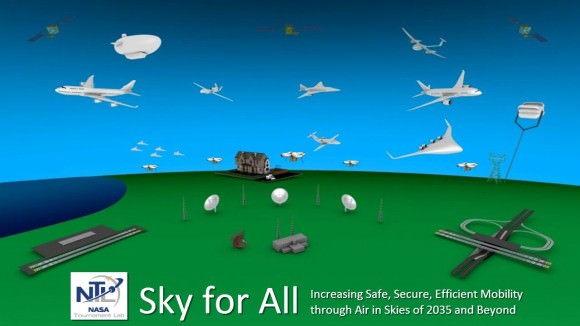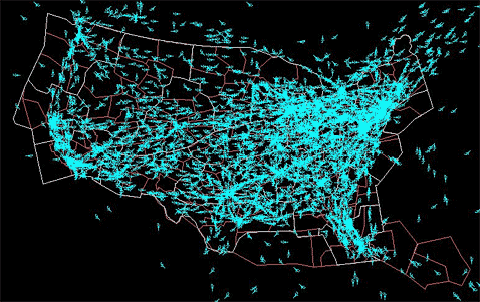According to a recent report by the US Federal Aviation Administration (FAA), airports across the country are seeing record passenger numbers. Along with that comes congestion at airport terminals and runways, causing delays and other problems — including accidents. The FAA report said if nothing is done to curb congestion by 2030, the busiest US airports will see problems rise dramatically. While infrastructure such as terminals and runways can be expanded or enhanced there’s one piece of the airport real estate that can’t be expanded: airspace.
As airspace becomes increasingly crowded with additional planes, and with the upsurge in vehicles like drones and other various aircraft, experts from the aerospace division at NASA say our current air traffic control system is not equipped to handle the predicted volume or variety of aircraft predicted for 2035 and beyond.

To overcome this challenge and ensure safe access for all commuters, HeroX and the Ab Initio Design element of the NASA Safe Autonomous Operations Systems (SASO) Project is asking for help in designing an airspace system that allows vehicles to safely and efficiently navigate dense and diverse future airspace.
“NASA is reaching out to the problem-solving community, asking innovators to cast aside the restraints of current transportation models and develop a clean-slate, revolutionary design and concept of operations for the airspace of the future,” says a new challenge called “Sky For All” posted on the HeroX website.
HeroX is an organization that uses incentive prize challenges as a way to spur innovations to solve problems. Prizes for this “Sky for All” challenge will be have a total prize of $15,000, with First Place receiving $10,000, Second Place $3,000 and Third Place $2,000.
The problem is that experts estimate that twenty years from now, 10 million manned and unmanned vehicles may traverse the U.S. airspace every day, up from the current 50,000 operations per day.
“The U.S. airspace system evolved over time in response to accidents and changing technology,” says the HeroX challenge page. “Current operations support approximately and boast the highest safety record of any mode of transportation, but this system has approached saturation and will not scale to accommodate future needs. Our goal is to build an airspace system that scales to 10 million vehicles per day (including personal air vehicles, passenger jets, unmanned vehicles of various sizes and speeds, stationary objects, space vehicles, etc.) by the year 2035.”
To achieve this, a “breakthrough” in airspace system design and concept of operations is needed as new vehicles — such as drones of various sizes operating at different altitudes, commercial space launches, wind turbines in jet streams — are already being introduced into the airspace.
“We want airspace that can scale to full capacity under normal conditions and scale back to equally safe, reduced capacity under degraded conditions,” says HeroX.
Innovators are asked to use a “clean-slate” approach of coming up with completely new designs and concepts of operations, and include ways to deal with issues such as protection from cyber-attacks and an ever-changing global environment.
This challenge is currently open to pre-registration and final guidelines will be posted when the challenge officially launches on September 22, 2015.
See all the information about the challenge here. Submissions will be due by November 17th, 2015, with the winners announced on December 15th, 2015.
Additional info: NASA Safe Autonomous Operations Systems
Note: Universe Today publisher Fraser Cain is also an employee of HeroX. But this article wasn’t sponsored in any way.


I quit flying (my own plane) not too long ago in part because “See and Be Seen” simply was not adequate, especially in the crowded skies of the northeastern U.S. where I live. It IS too crowded up there. Don’t think so? Log onto http://www.flightradar24.com and take a look – and that shows only the planes with active, modern transponders and ADS-B transponders. And that begs a question or two:
Nancy, why no mention of the present ADS-B system? It is expensive (per plane). It is late coming. But it works! And when fully and properly implemented it will accomplish very close to all they need.
Also, what sort of truly thoroughly and intelligently devised “system” can they expect for that whoppingly huge reward of all of ten thousand bucks? In this day and age it takes millions just to develop a prototype of a competitive smart phone! They can’t be serious!
that represents an awful lot of pollutants being emitted directly into the atmosphere.
Not as pollutants much as cars and trucks and power plants, by a damn sight!
Or would you rather spend a month at sea getting to Europe?
actually it takes 5 days to get to London. The amount of fuel / person to get there is the real issue.
I meant under sail.
(Although it’s been done in just over three days, west to east, my mind went back to square riggers.)
we got here in Europe resolved that by using high speed trains. In theory a plane would be faster, but getting to an airport, checking in 2 hours before…just makes you get there much faster by a high speed train , and you get right in the middle of the town you want. The fact that you can lose a 747 and don`t find it 2 years later doesn`t impress me.
Those of us Americans who understand are jealous of your trains. Over here we can’t get the politicians to even just maintain what we have. AND the best we can do, on the east coast, is 150 miles per hour for very short sections of the run from New York to Boston.